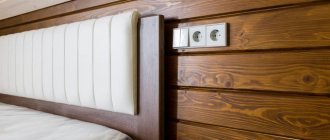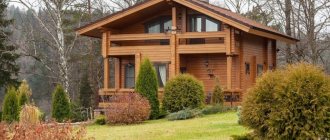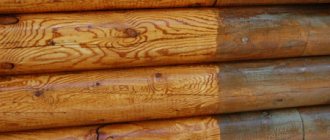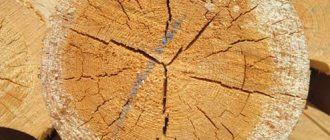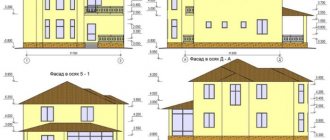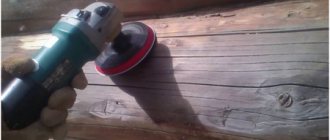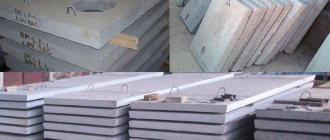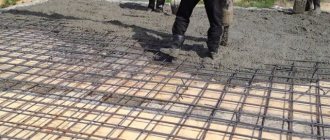Fire retardants for wood are simple substances, chemical compounds, mainly of inorganic origin, which are introduced into the surface layer and internal structure of wood in various ways, leading to a sharp decrease in the flammability parameters of the material.
Wood protection compositions based on fire retardants are developed and used:
- from short-term exposure to open fire,
- initiation of the pyrolysis process,
- ignition during high temperature heating.
Purpose of the substances - the use of fire retardants for wood allows for both surface and deep fire-retardant impregnation of structural materials and interior decoration elements in residential and industrial construction, as well as in the production process of materials to reduce the flammability of wooden parts.
Many fire retardant compounds are often briefly referred to as fire retardants, necessary for the impregnation and processing of wood and materials made on its basis.
Testing samples of wood treated with fire retardants
Antiseptics for wood
Antiseptics or antiseptic impregnations for wood are chemical preparations that protect wood from biological destruction (rotting, woodworm damage, mold, house fungi).
Nomenclature of antiseptics:
| 1 | Antiseptic paste. The best protection against house fungus | PAF-LST |
| 2 | Leave-in antiseptic for external use | XM-11 |
| 4 | Sanitizing antiseptic | HMF |
| 5 | Toning antiseptic | HMHA |
| 6 | Antiseptic for blue stains | BS-13 |
| 7 | Antiseptic “double protective shell” | HMBB |
| 8 | Antiseptic “multifunctional protection” | FBS |
Fire retardants for wood
Fire retardants or wood fire retardants are chemicals that protect wood and wood-based materials from exposure to fire.
Nomenclature of fire retardants:
| 1 | Fire retardant. 2nd group of fire retardant efficiency | MS(0-1) |
| 2 | Fire retardant. 1st group of fire retardant efficiency | |
| 3 | Fire retardant varnish. Fire protection and decorative finishing of wooden elements of premises | OZL-SK |
| 3 | Fire retardant transparent paint. Fire protection and decorative finishing of wooden building structures | Phoenix DP |
| 3 | Fire retardant white paint. Fire protection and decorative finishing of wooden building structures | Phoenix DB |
| 4 | Fire retardant white paint. Fire protection and decorative finishing of wooden building structures | Fire protection+ |
Decorative properties of impregnations
Impregnations are produced transparent or tinted (in accordance with the manufacturer's range of tones). Only antiseptics have a decorative effect. Completely transparent (colorless) antiseptics perform an exclusively protective function without changing the natural color of the wood. The maximum they can do in decorative terms is to emphasize the structure of the wooden covering. A similar composition is Tikkurila Pinja W-Oil antiseptic. It is absolutely colorless, but can be easily tinted in any of the tones from the Tikkurila line.
Tinted antiseptics are originally colored. They are either produced in a specific color range, or are tinted upon sale, according to the color chart offered by the manufacturer. Such impregnations simultaneously play both a protective and decorative role. That is, they can replace other coloring materials: primers, stains, paints, varnishes. A well-known similar antiseptic is Pinotex Classic, its color card includes 10 main tones and 20 additional ones. In addition, the Pinotex Classic composition allows you to obtain many other tones by mixing existing shades in different proportions.
What about fire retardants? Most of them are colorless and once dry are not noticeable. Others are painted pink or red, which plays a controlling rather than a decorative role. By applying colored impregnation to a wooden surface, it is easier to monitor the quality of the coloring and the absence of gaps.
In addition to everything indicated, when choosing impregnation, pay attention to:
- Safety. Read the ingredients on the product label. Make sure that no highly toxic compounds are used in the manufacture of the antiseptic (fire retardant): arsenic, pentachlorophenol, fluorine compounds, heavy metal salts.
- Duration of fire and bioprotection. Fire retardants act on the treated surface for up to 7-15 years, antiseptics – for up to 10-20 years.
- Manufacturer. Well-known impregnating compositions that have a quality certificate and are appreciated by consumers are produced under the following brands: Pinotex (Finland), Tikkurila (Finland), Neomid (Russia), Senezh (Russia), Belinka (Slovenia).
Fire protection products for wood
Wood fire-bioprotection products are complex fire-bioprotective preparations (antiseptic + fire retardant) that protect wood from biological destruction (rotting, woodworm damage, mold, house fungi) and exposure to fire.
Nomenclature of complex drugs:
| 1 | Antiseptic and fire retardant | MS(PKO) |
| 2 | Low-toxic antiseptic and fire retardant | BB-11 |
| 3 | Non-washable antiseptic and fire retardant | HMHA-1110 |
| 4 | Antiseptic against blue stains and fire retardant |
Antiseptics, fire retardants MS(01), PP and fire-bioprotective drugs are supplied in the form of dry powder and in the form of a ready-made working solution. Dry antiseptic can be prepared at the point of consumption by dissolving in warm water. In this case, it is necessary to dissolve the entire powder so as not to disrupt the required ratio of components in the finished solution. Ready-to-use solutions are supplied in 5, 10 and 30 liter canisters.
Composition of fire retardants
Fire retardant solutions, powders and other materials may contain different fire retardants, both individually and in combination. The variety of fire retardant compositions has already been mentioned above. In order to present this more clearly, let us summarize in one table some information about the most commonly used fire retardants.
| Type of fire retardants | Substances and chemical compounds that determine fire retardant properties | Main mechanism of action |
| Phosphorus-containing | Polyphosphates - organic and inorganic phosphorus compounds; also include bromine or chlorine atoms. | Polyphosphoric acid is formed, causing dehydration and carbonization processes. |
| Hydroxides | Aluminum hydroxide Magnesium hydroxide | The decomposition of the resulting salts with the release of cooled water vapor and a refractory residue. |
| Borax and boric acid | Boron atoms | Retards the ignition of flammable gases formed during the decomposition of cellulose. A hard sedimentary film is formed. |
| Intumescent mixtures | Ammonium polyphosphate, pentaerythritol (4-hydric alcohol), melamine and derivatives. | Swelling is a protective layer that expands many times. |
| Polymer nanocomposites | Layered silicates Carbon nanotubes | Formation of a heat-insulating carbonized layer. Slowdown of heat release during polymer destruction. |
| Halogen-containing | Chlorine, bromine | They form low-temperature water vapor, stimulating the coke formation process. |
| Eco-flame retardants | Organic waste from pulp and paper production: oxidized starch - OCR, oxidized lignin - OL. | OCR - foams, increases volume and releases gases that reduce the amount of smoke generated by flammable tree resins. OL—surface coke formation. |
The world is constantly studying the impact of fire retardants on the environment and human health. Some still certified and even popular halogen-containing flame retardants are considered dangerous, and phosphorus-containing flame retardants are considered potentially dangerous, as are some of the metal-containing flame retardants.
At the same time, much attention is paid to synthetic polymers, PD ceramics and liquid glasses, so the environmental safety of fire retardants based on them is considered proven.
Fire protection means for steel building structures and cable lines
Fire retardant coating and paints that increase the fire resistance of steel structures from 0.5 to 2.5 hours. Phoenix CE paint, which reduces the fire hazard of cable lines.
Range of fire protection means for steel building structures and cable lines:
| 1 | Fire retardant coating. 1st - 5th group of fire retardant efficiency for steel structures | OPV-1 |
| 2 | Fire retardant paint. Increasing the fire resistance of steel building structures from R30 to R90 | Defender M |
| 2 | Fire retardant paint. Increasing the fire resistance of steel building structures from R45 to R90 | Defender M Solvent |
| 2 | Fire retardant paint. Increasing the fire resistance of steel building structures from R30 to R90 | Phoenix STS |
| 2 | Fire retardant paint. Increasing the fire resistance of steel building structures from R30 to R90 | Phoenix STV |
| 3 | Fire retardant paint. Fire protection agent for cable lines | Phoenix SE |
Regulatory requirements
The need, organization, timing of processing of building structures, finishing materials made of wood, testing methods for fire retardant compounds are indicated in the following legislative acts and fire safety standards:
- Federal Law No. 123, Article 136 of which defines the need to indicate in the documentation for fire retardant agents parameters characterizing the area of use, the effectiveness of fire protection, methods of preparing protected surfaces, applying compositions, coatings, and warranty periods of operation.
- The PPR in the Russian Federation defines the responsibility of facility managers for the timely elimination of damage to fire retardant coatings, annual inspections of their condition, re-treatment of building structures at the end of the warranty period for the effectiveness of fire protection, determined according to the report of the previous work, the instructions of the manufacturer of fire retardant compounds.
- NPB 251-98, GOST R 53292-2009 – on regulations for testing fire retardants for wood.
- GOST 16363-98 – on methods for determining the fire retardant characteristics of such products.
When conducting certification tests of materials and fire retardant compounds used for their processing, they are also guided by the following requirements:
- GOST 30244-94 – on test methods, classification by flammability groups.
- GOST 30402-96 – the same for flammability.
- GOST R 51032-97 – the same for the spread of open flame.
A large number of regulatory requirements for fire retardant substances and materials for wood processing are related to the fact that they are included in the list of products that are necessarily subject to certification in the field of fire safety.
Water repellents
Water repellents are designed to protect artificial and natural stone, brick, concrete, expanded clay concrete, aerated concrete and other building structures and materials from exposure to water. Giving hydrophobic (water-repellent) properties to building materials. Protection of antiseptics from leaching.
Range of water repellents:
| 1 | Water repellent (composition) | GKZh-11 |
| 2 | Water repellent (concentrate) | GKZh-11 |
Water repellent GKZh-11 is supplied in the form of a ready-made working solution - Composition GKZh-11 or in the form of a concentrated liquid - Concentrate GKZh-11. The working solution is prepared at the point of consumption by mixing the concentrate with the appropriate amount of water.
Antiseptics, flame retardants and fire-retardant preparations for wood protection can be used either independently or in combination with other preparations and painting compositions. Antiseptics and fire retardants that protect wooden structures from biological agents of destruction do not protect them from solar radiation, wind erosion, or mechanical damage. Creating a protective film on the surface of wood from painting compounds partially solves this problem, and the combined use of antiseptics, fire retardants and painting compounds in the widest range solves the issue of protecting wooden structures from destructive factors. After impregnation of wood with preparations (except PAF-LST), the wood is easily glued and painted.
Let's consider various areas of application of antiseptics, fire retardants and fire protection agents when processing wooden building structures:
Kinds
There are two types of fire retardant compounds, which are based on substances and chemical compounds that are fire retardants:
- For deep fire-retardant impregnation of lumber under pressure in industrial autoclave units, technological heating/cooling mode in open baths with a hot solution of fire retardants; or by the method of repeated surface application of innovative compositions that are capable of being deeply embedded into the internal structure of the protected material without additional external influence - heating solid wood, increasing pressure.
- For surface fire retardant treatment . This type of fire retardant solutions, ready for use or prepared immediately before work on construction sites, in attics, on roofs, rafter systems of newly built objects, mainly includes traditional compositions that have been used for decades.
Method of application - with paint brushes, rollers, spraying with construction spray guns, usually in two layers with a significant drying period for the coating between re-application of the fire retardant composition.
Upon completion of work to increase the resistance to short-term exposure to fire of building structures and finishing elements, only the surface layer of wood is impregnated with fire retardants of this type.
In addition, the fire retardant composition can be one of two types according to the quality of wood impregnation, which is determined by the transfer of the processed materials:
- In group I of fire protection efficiency , which means the transfer of wood to a difficult-to-burn state, when samples of building structures treated with this composition during certification tests of serial products lose no more than 9% of their mass.
This is achieved by deep impregnation or repeated coating of wood surfaces with modern compounds that have a certificate of compliance with fire safety requirements for this fire protection efficiency group.
- In group II , when, after fire-retardant impregnation, the wood becomes a highly flammable material and, during laboratory tests, loses no more than 30% of the total mass of the samples under study.
CONCLUSION: For builders, customers, and owners of facilities where fire retardant treatment of lumber and wood building structures is carried out, the best choice is the use of fire retardant materials of fire protection efficiency group I, due to a significant increase in the period until the next treatment required by fire safety standards.
Preparations for external use
To protect against damage by airborne and atmospheric fungi to wooden structures susceptible to being washed out by precipitation:
- log houses and external cladding of walls of houses, sheds,
- wooden fences (fence, palisade, etc.),
- path flooring,
- ridge fence,
- frames of greenhouses and cornices,
- bridges, boats, etc.
Antiseptics based on chromates are used, including XM-11, XMF, XMBB, XMHA. At the same time, the XM-11 antiseptic is most effective for protecting wood working in the ground, in water and under the influence of precipitation. Antiseptic CMF is effective in protecting wood with increased impregnation capacity, including old and partially rotten wood. The antiseptic HMBB in impregnated wood forms a double protective shell, because compounds of the BB group penetrate to a depth of 10-50 mm, those of the XM group - to a depth of 5-25 mm, as a result, the protection of the impregnated zone remains stable over time throughout the entire thickness. Antiseptic HMHA paints wood in favorable decorative colors.
How does a fire retardant work?
All existing fire retardants pursue the same goal - to suppress the process of ignition and fire spread as effectively as possible. At the same time, the technical principles for solving the problem may vary greatly among different fire retardants. Two large groups can be distinguished:
- Fire retardants are inert, which do not affect the combustion process in any way, but simply form a protective layer on the surface that prevents the penetration of fire.
- Active flame retardants fight combustion itself, which is a chemical process of rapid oxidation. Everyone knows: to stop it, you need to stop the supply of oxygen or sharply reduce the temperature. Therefore, substances that react as fire retardants are used:
- endothermic, when heat is absorbed;
- in which non-flammable gases or water vapor are released; as a rule, in this case refractory residual formations are still formed;
- changing the course of combustion reactions; for example, they shift the emphasis from surface flame propagation to the coking process.
A fire retardant can be of inorganic, organic or mixed origin. This can be a metal salt, hydroxide, specially treated paraffin or graphite, and more. Due to environmental conflicts, many flame retardants cease to be relevant when not only their effect is assessed, but also its consequences.
Attention! The use of materials containing bromine and phosphorus as fire retardants should be limited if possible, since they provoke negative physiological and environmental processes.
Safe ones include traditional flame retardants - magnesium and aluminum hydroxides. When exposed to high temperatures, they release water vapor, which, as a result of an endothermic reaction, is cooled below the temperature required to support combustion. Naturally, the pyrolysis process , but the formation of a solid protective layer is catalyzed.
New generation environmentally friendly flame retardants are becoming increasingly popular: fusible glass, organic eco-flame retardants. Particular attention is paid to the so-called intumescent flame retardants, in which, with increasing temperature, a volumetric change occurs—multiple thermal expansion. Coatings containing these substances successfully replace old thick thermal insulating and oxygen-impermeable asbestos plasters, mineral wool, and expanded vermiculite.
All this was effective, but quite expensive, and most importantly, it significantly made the structure heavier, negatively affecting its strength. The mechanism of action of an intumescent fire retardant is simple and effective: when heated, gas bubbles are formed inside a thin, approximately 2 mm, coating, due to which the coating expands 10-40, and sometimes 100 times, forming the so-called foam coke, which is heat-insulating and non-flammable.
Thus, there are many flame retardants of different compositions and different mechanisms of action. Let's figure out in what cases they need to be used.
Preparations for internal use
To protect wood from damage by mold, wood-staining, wood-destroying fungi and wood borers:
- walls from inside the house,
- partitions,
- roof structures (rafters, sheathing),
- interfloor and attic floors
antiseptics based on borrates are used: BB-11, KhMBB, , FBS.
At the same time, the preparations BB-11, BS and wood impregnated with them are the safest for humans and warm-blooded animals, and the FBS antiseptic provides multifunctional protection of wooden structures from a wide range of biodegradation.
Protection against house fungus
To protect against damage by house and soil fungi to wooden structures operating in conditions of poor ventilation, condensation, difficult to inspect, buried in the ground, etc.:
- lower crowns from the basement,
- floor beams above basements,
- black floors,
- logs,
- the ends of the beams, laid in the nests of the masonry,
- Mauerlats,
- contacts of wood with stone or metal
antiseptics based on fluorides and borrates are used: PAF-LST, HMF, BB-11. In this case, the most effective is the antiseptic paste PAF-LST, but it contaminates the surface of the wood, making it unsuitable for subsequent gluing and painting.
Protection of baths and saunas with antiseptics
To protect the finishing of baths from the inside, the use of preparations XM-11 and BB-11 is most effective. During the operation of baths and saunas, water gets on the floor and logs, so to protect them it is necessary to use a non-washable antiseptic XM-11, because other antiseptics will gradually be washed away over time under the influence of water and the protection will lose its effectiveness. This will not happen when using XM-11, because... After applying this drug, it crystallizes and does not dissolve back with water, remaining in the wood and protecting it. There is practically no water getting on the ceiling and walls of the bathhouse, so the fire-bioprotective drug BB-11 is best suited for their protection, as it is the most harmless to humans. In addition, it does not stain the wood, because... is a colorless preparation and allows you to leave the natural appearance of wood.
Penetration depth, flow rate
Composition consumption per sq.m is an important economic indicator that you should pay special attention to when purchasing. You should look not only at the cost for a specific packaging, but also estimate the required amount in terms of per square meter of processed area. For example, inexpensive salt formulations have a consumption 2-3 times higher than relatively expensive non-salt products - as a result, the apparent savings are reduced to zero.
Based on the depth of absorption, there are two categories of fire protection:
- capillary (surface) compositions - penetrate into the fibers no deeper than 6 mm;
- deep penetration compounds are capable of saturating wood to 12 mm or more.
It is more profitable to use surface fire-bioprotection, since it can be easily applied to structures with any available painting tool (brush, roller, spray gun). Such compositions do not create internal stresses in wood, which means the strength of the material does not decrease. Protection against deep penetration (in most cases, salt type) requires the use of special equipment for application, so this type of fire-bioprotection is rarely purchased wholesale or retail.

